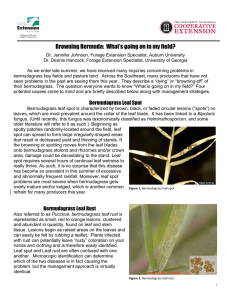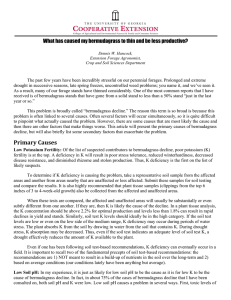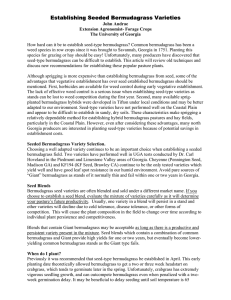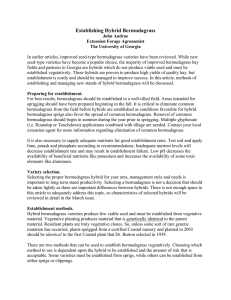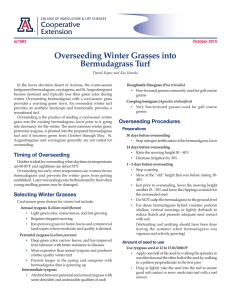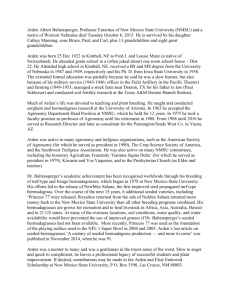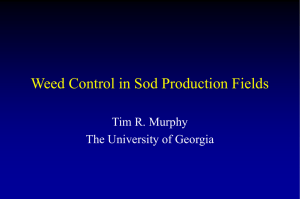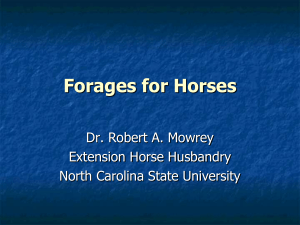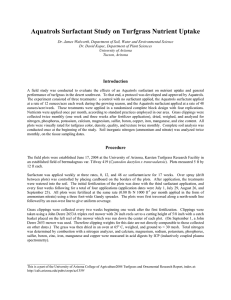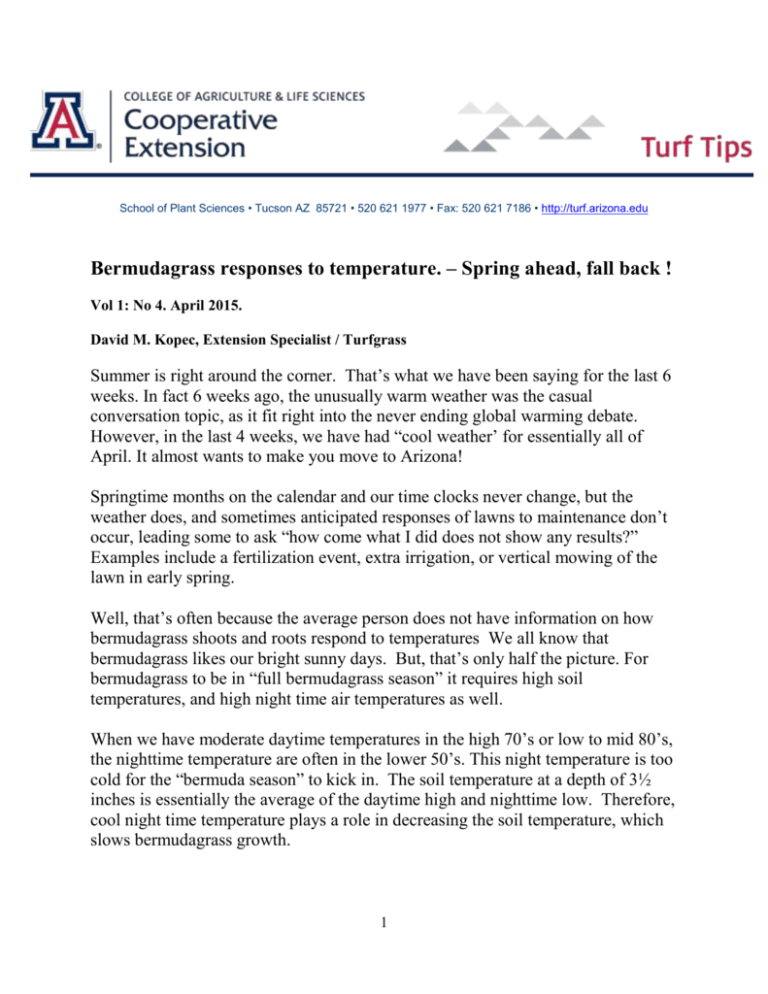
School of Plant Sciences • Tucson AZ 85721 • 520 621 1977 • Fax: 520 621 7186 • http://turf.arizona.edu
Bermudagrass responses to temperature. – Spring ahead, fall back !
Vol 1: No 4. April 2015.
David M. Kopec, Extension Specialist / Turfgrass
Summer is right around the corner. That’s what we have been saying for the last 6
weeks. In fact 6 weeks ago, the unusually warm weather was the casual
conversation topic, as it fit right into the never ending global warming debate.
However, in the last 4 weeks, we have had “cool weather’ for essentially all of
April. It almost wants to make you move to Arizona!
Springtime months on the calendar and our time clocks never change, but the
weather does, and sometimes anticipated responses of lawns to maintenance don’t
occur, leading some to ask “how come what I did does not show any results?”
Examples include a fertilization event, extra irrigation, or vertical mowing of the
lawn in early spring.
Well, that’s often because the average person does not have information on how
bermudagrass shoots and roots respond to temperatures We all know that
bermudagrass likes our bright sunny days. But, that’s only half the picture. For
bermudagrass to be in “full bermudagrass season” it requires high soil
temperatures, and high night time air temperatures as well.
When we have moderate daytime temperatures in the high 70’s or low to mid 80’s,
the nighttime temperature are often in the lower 50’s. This night temperature is too
cold for the “bermuda season” to kick in. The soil temperature at a depth of 3½
inches is essentially the average of the daytime high and nighttime low. Therefore,
cool night time temperature plays a role in decreasing the soil temperature, which
slows bermudagrass growth.
1
Even when the bermudagrass greens up in early spring, during cool nights, the
temperature at the surface of the grass leaves the temperature in the top inch of soil
can also be low. The surface stolons of bermudagrass reside in this layer, and their
physiological growth processes are dramatically limited by the cool night
temperature they experience.
In a nutshell, the bermudagrass is full steam ahead when the night time low
temperature is at least 60F for seven nights in a row. That’s when bermudagrass
will respond most favorably to,
nitrogen fertilization
vertical mowing (removal of thatch)
aerification of any kind
establishment from plugging, seeding, or sprigging
During the first weeks of this past April, applying anything over ¼ lb. of nitrogen
per 1000 sq. ft. on bermudagrass gave mixed results. At first the grass may have
turned greener with some top growth, followed by the same turf turning lighter
green with lesser amounts of growth 2 weeks later. A follow up with more
nitrogen also has essentially no added benefit. Here’s why.
The bermudagrass combines applied nitrogen with stored carbohydrate reserves,
making proteins, the building blocks of leaves and stems. When the nighttime
temperature is low (less than 50F), only a small amount of new carbohydrate is
being made and stored, even if the daytime temperature is 80F or more ! The end
result is that the bermudagrass slows down its overall growth, as no appreciable
amounts of new food is being stored when night time temperatures are below 60F.
Additional nitrogen has no effect when it’s too cool for the plant to process and use
it efficiently. Nitrogen efficiency and grass growth increase as the night time
temperatures, along with the soil temperature, rise accordingly. While we sweat at
80F daytime temperatures, the bermudagrass is really only on “green standby”.
In early spring when the night temperatures are in the low 50 F range, apply iron as
a spray solution, to hasten green –up and color retention, as opposed to nitrogen
applications.
So remember that our spring weather often shows tremendous day and night time
temperature swings, sometimes as great as 30F! In the spring, the bright sunlight
and daytime temperatures are warm enough to get bermudagrass leaves green, but
the nighttime temperatures are cool (50-55F). “Pushing” the plant for more growth
2
is not beneficial to the health of the bermudagrass at such times. Avoid applying
nitrogen at normal “summer time rates” (0.5lbs. or more per 1000 sq. ft.). Also
avoid “early season cultivating of the soil/turfgrass (vertical mowing for removing
thatch, or aerification of any sort) which also is a stress on the bermudagrass lawn
at “green-up”. When done in the heat of the summer, these maintenance items are
beneficial to bermudagrass. While we never change our clocks in Arizona, the
weather certainly changes, and so does the appearance of bermudagrass, especially
in the spring !
The table below lists the temperature responses of bermudagrass shoots and
roots to soil or air temperature.
“Issued in furtherance of Cooperative Extension work, acts of May 8 and June 30, 1914, in cooperation with the U.S. Department of Agriculture, Jeffrey C. Silvertooth,
Cooperative Extension, College of Agriculture & Life Sciences, The University of Arizona.
The University of Arizona is an equal opportunity, affirmative action institution. The University does not discriminate on the basis of race, color, religion, sex, national
origin, age, disability, veteran status, or sexual orientation in its programs and activities”
3

